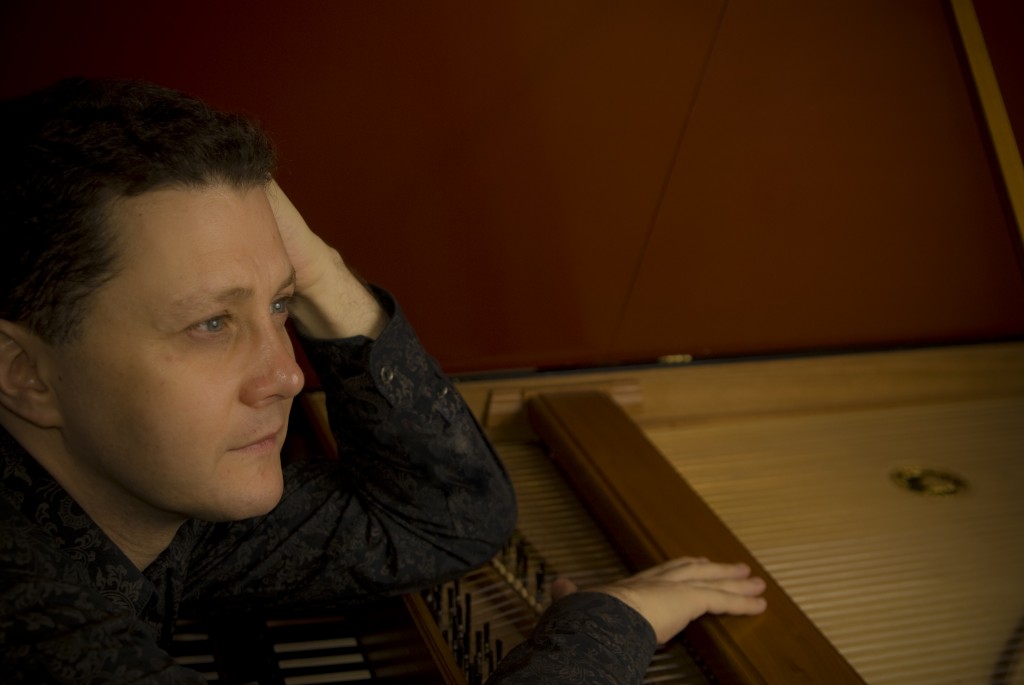Jory Vinikour’s artistry in Rameau prevails over ill-tempered harpsichord

Jory Vinikour performed music of Rameau Thursday night to open Salon Sanctuary’s season. Photo: Kobie van Rensburg
This year’s sesquicentennial of the death of Baroque polymath Jean-Philippe Rameau (1683-1764) might not be as sexy as the Richard Strauss centenary, but it is every bit as important to note. Without Rameau’s Gallic contributions to opera, pedagogy and music theory at large (harmony, especially), there would be no Gluck or C.P.E. Bach. What better way, then, to mark Rameau’s passing 250 years ago than with an all-Rameau concert from one of today’s foremost harpsichordists, Jory Vinikour?
The Chicago native-cum-Parisian expat remains the composer’s most learned interpreter; Vinikour’s debut recording for Sono Luminus of Rameau’s complete harpsichord oeuvre was nominated for a 2012 Grammy.
Kicking off the sixth season of Jessica Gould’s roving Salon/Sanctuary series Thursday night, Vinikour played an expertly curated, near flawless program–all from memory–that showcased both the composer’s brilliance and his own virtuosity.
Opening with the illustrative Le Rappel des Oiseaux (“The Gathering of the Birds”), so telegraphed was Vinikour’s ornamentation that the two-part tritones almost went unnoticed. Likewise, the minor mode filagree of Rigaudon and the registral refrains of Musette were so well-rehearsed that Rameau’s often thorny suspensions didn’t so much startle the crowd at Abigail Adams Auditorium as they surely did during his day. Vinikour’s violent-sounding bass line in the Tambourin, the only such dance Rameau would write for the clavecin, had more reckless abandon.
Rameau’s formal logic and economy of means is clear even without extramusical associations of course, but Vinikour’s most enjoyable moments in the first half came during programmatic pieces like La Poule (“The Hen”) and L’Entretien des Muses (“The Conversations of the Muses”). The clucking over the melody of the former and the plangent trills that never quite resolve in the latter showed a lighter side of Rameau that’s still worth savoring.
Les Cyclopes, perhaps the great showpiece of the Baroque harpsichord, received a deftly inspired rendition under Vinikour’s hands. Structurally, it remains a modified rondeau, but watching Vinikour navigate through all the cross-handed arpeggios and Scarlatti-ish repeated notes in the second couplet, one need not follow the score to fully appreciate Rameau’s evocation of the Cyclops’ hammers.
A longer intermission was needed to retune the instrument David Jacques Way and Marc Ducornet built together in 1994. To modern ears listening to less faithful reproductions, the harpsichord can sound sort of like an electronic synth. Way and Ducornet’s beautiful recreation–hand-painted with swirling flora and, curiously enough, a gray egret–proved timbrally authentic, but it simply could not hold its tuning.
Vinikour did his best to bring the instrument back from the brink (the air conditioning was turned off, as well), but Rameau’s sprawling Suite in A minor indubitably suffered in the second half. Vinikour half-heartedly joked that the Allemande, Courante and Sarabande would be in “cruel tone temperament” instead of pure “mean tone”; however, he was forced to sacrifice a lot of the nuances inherent to a piece like Les Trois Mains (“The Three Hands”). Important cadential markers could not be given full repose, lest we suffer the beating of historically uninformed intonation.
The quicker tempi of Rameau’s grand gavotte and its six difficult variations fared much better in that respect, as did Vinikour’s encore: Claude-Bénigne Balbastre’s transcription of the overture to Rameau’s celebrated act de ballet, Pygmalion. Just as Cupid found a replacement lover for Céphise in Ovid’s tale, one wished a player of Jory Vinikour’s stature was given another harpsichord worthy of his kind of Rameau.


